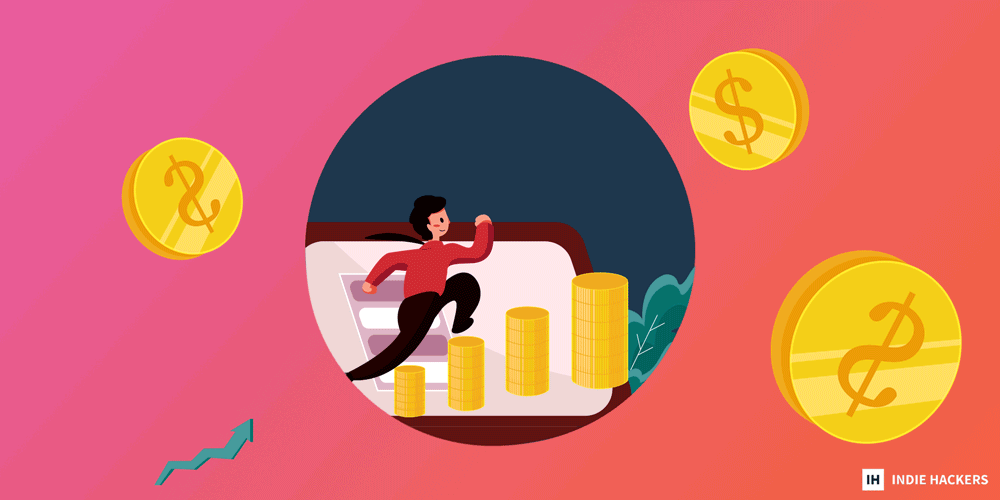What happens when you're building an MVP and a competitor beats you to market? - **Dealing with competitors can be a tough course to navigate** mentally, emotionally, and professionally. Below, founders share tips on handling competition in a healthy
What happens when you're building an MVP and a competitor beats you to market?
-
Dealing with competitors can be a tough course to navigate mentally, emotionally, and professionally. Below, founders share tips on handling competition in a healthy way.
-
Adulting is hard, and consumers are looking for ways to bring more play into their lives. Searches for adult crafts, pigtails, and fairy bedroom ideas are soaring, and founders can cash in on the fun.
-
Founder Tomas Riegos built a fully native mobile app MVP in 6 days using no-code tools. Here's the exact roadmap that he followed, including resources and tools!
Want to share something with over 95,000 indie hackers? Submit a section for us to include in a future newsletter. —Channing
🥊 How Do You Handle Direct Competitors?

by Omar Rwemi
I had a SaaS idea for a product that solves a huge problem in my local community. I started working on an MVP, but was surprised to see that someone else recently launched the exact same idea. I was devastated. It was such a brutal reality check.
What makes it worse is that they seem to have financial support, and they're pushing new features fast. At this point, I'm totally depressed and feel that my product has been crippled. Should I keep building?
De-risking the space
0xbadcafe says that this is great news!
You have a competitor, which means you have additional proof that you are on to something. Building a new product in a completely new space is risky, and having a competitor has helped de-risk your work.
They're shipping features fast? Great. Use their work to understand what you should build. Put your users in front of their product, and get feedback on what is and isn't important. Use that to decide your roadmap. That's cheaper than building the wrong thing.
They're advertising heavily? Fantastic. Track all of their ad copy and keywords in a spreadsheet, and watch how it changes over time. When you're ready to pay for ads, use that spreadsheet to understand what works. They're paying for you to learn!
Ivor Colson agrees:
Having a competitor is positive. It's inevitable for any successful business. You can learn from them, and it shows you that there's a market!
I'd recommend figuring out your unique proposition, if you haven't already. Why would a customer choose you over them? Is it the type of customer that you deliver your solution for? Is there a unique approach in your solution?
Overall, this is good news. It will get you started in thinking about your unique offering and positioning, which is crucial for your success!
Potential collab
Mark Grimes sees it as an opportunity to potentially collaborate:
This is a tough situation, and mental health for founders is a hard one. Being around other founders, both online and in real life, is very important.
I have some advice that everyone may not like. As we all know, the magic is in the execution, not necessarily in the idea. I'd approach the founder of the competitor company and let them know that you had a strikingly similar idea. I'd then offer to work with them to help build. They're building fast, executing, and appear to have financial support. Help them, get paid, and work with them to grow it as much as you can.
More than anything, whichever direction you want to go, stay positive and build a community of supporters around you.
Niche down, charge more
Idir Yacef says that this could pave the way to charge more than the competitor does:
I wouldn't worry about it. First off, if the idea is good, you're not going to be the only one in the market anyway. Secondly, running ads or pushing features doesn't mean growth. Some companies push a feature every week, and spend thousands of dollars on ads, yet get nothing in return.
You can leverage cold emails to get your first customers, while also focusing on SEO for the long run. You can go after a different ideal customer, and if your idea solves a major problem, you can charge even more than your competitor does.
You're going to have competitors and people trying to copy your product, your landing page, your blog posts, your tweets, and everything you do. This means that your product is worth it, and that alone should give you hope to keep going forward!
I know that it can be frustrating, but you've come this far. You have an idea in mind, so keep going, no matter what problem you face!
Take care of your mental health
Adam Isaacs Rae reminds founders to prioritize mental health in these tough situations:
The single most important thing that every single person on earth could do is to work on their mental health. Good for you for recognizing the effects that this is having on you.
This is where I am so grateful to have an amazing cofounder. Perhaps finding a cofounder is something worth considering for you? Many hands make light work.
Ropesneer agrees:
You said that you feel bitter, envious, depressed, and burned out, and that you're not pleased with yourself for feeling that way.
But here's the thing: You have to allow yourself to feel such emotions. There is nothing wrong with the way you feel! After you process those emotions, give yourself a deadline to move on productively. This can be whatever "moving on" means for you: Whether it's continuing to work on your solution, or working on something else, find a way to keep going.
How do you deal with direct competitors? Share in the comments!
Discuss this story.
📰 In the News

from the Volv newsletter by Priyanka Vazirani
🤐 Facebook has banned staff from open discussions on abortion.
💰 This startup is giving cash to ex-employees to start companies.
🍔 One of the most famous crypto restaurants is no longer accepting crypto.
👽 This 1992 sci-fi novel accurately predicted some of today's tech.
🎵 Here's how people make money on TikTok.
Check out Volv for more 9-second news digests.
😝 Grownups Just Wanna Have Fun

from the Hustle Newsletter by Ethan Brooks
The Signal: We get it...adulting is hard.
Consumers are looking for ways to bring more play into their lives, with searches for adult crafts, pigtails, and fairy bedroom ideas soaring.

*Global search volume increases from Pinterest's 2022 Trend Report
Brands could leverage the trend in their ads, and on social. For example, #DisneyAdults is going wild on TikTok!
Or, focus on giving consumers more room to play via:
1. Activities: It's no longer just the kids who get to have fun yard parties. Founders could target interests like these:
-
Searches for "adult bounce house" are up 87% on Amazon over the last 90 days, per Jungle Scout.
-
There are 8.4K+ searches for "adult party favors" per month on Amazon (+78% since February).
-
"Scavenger hunt ideas for adults" is searched 2.4K+ times per month in the US, per Ahrefs.
2. Food and drink: Move over, steamed vegetables. TikTok's #FunFoods has 289M+ views. Founders could re-market fun, popular children's options to adults, like sprinkle desserts: #Sprinkles has 1.5B views.
Another angle is healthier, adult versions of classic kids meals. Startup Goodles is playing in this space with its plant-based, high-protein noodle range. The company launched in 2020, and interest is cooking. Its site gets ~80K visits per month, and it recently raised $10M+.

*Goodles is taking advantage of the retro marketing trend. Source: Instagram
3. Agere: Okay, this one's weird, but you know we're no strangers to weird industries at Trends.
Agere stands for "age regression." Clinically, age regression occurs when someone unconsciously reverts to a younger state of mind, resulting in childlike behaviors.
But there is a trend popping up around experimentation with voluntary, self-regulated age regression as a self-help tool to reduce stress. This can include participating in favorite children's games, food types, activities, etc.
The term is going wild on both Pinterest and Google (40K+ US searches per month), and #Agere has 558M+ views on TikTok. Subscribers to the agere subreddit ("take yourself back to simpler times") have doubled over the last year.

*Monthly US Google search volume, six month rolling average. Source: Ahrefs
An entire market is forming around practitioners. SmolGear is an Etsy seller of adult pacifiers (yes, you read that right); a median price of $9 and 9.4K+ sales puts revenue at ~$85K. It's important to note that this is not some kind of kink; agere has no sexual connotations.
Etsy is likely just the tip of the iceberg. Reddit suggests that many are looking for options with discreet shipping and storage to test out before taking the plunge. Other product ideas include mystery boxes, bottles, and clothing.
Ahrefs shows that there are ~13K monthly Google searches for "adult pacifier," but the keyword difficulty rank is still zero, meaning that you will need very few, or no, backlinks to rank in the top 10.
And, in case you were wondering how big the market may get: This US-based agere site already averages ~100K monthly visits, and 94% of traffic is organic, per Similarweb.
Would you enter the adult kidding around space? Let's chat below!
Subscribe to the Hustle Newsletter for more.
👥 10M Users, Zero Funding

by Aytekin Tank
Staying healthy and happy:
Progress is inspiring.
Research shows that nothing boosts emotion, perception, and motivation more than making progress in meaningful work, no matter how small each step may be. A singular focus ensures that everyone is on the same team, rowing towards the same destination. Each person can see how their direct contribution moves the whole group forward.
Discuss this story.
🛠 Tomas Riegos' Roadmap for a No-Code MVP

by Tomas Riegos
Hi indie hackers! I'm Tomas Riegos, and I built a fully native mobile app MVP in just six days using no-code tools. Here's how!
Why it matters
The founder we built the app for had gotten quotes from offshore dev teams with a timeframe of six months, and tens of thousands of dollars. However, when she told us the specs of her app, we knew that it could be built entirely in no-code, at a fraction of the time and cost, to get her to market as soon as possible.
How we built it
If you're at the stage between concept validation and MVP build, this process may be helpful for you. The concept is a community and event-first take on the outdoors. We followed this process to get her from idea to launch in record time:
1. Scope the roadmap: The first step is to get crystal clear on what exactly to include in the MVP build. We used a Notion template that I designed for product roadmaps. That helped us clarify the high-level user flows and spec features across the first four releases. Resource: The Product Management OS is a free template for non-technical founders to track their product vision, regardless of who’s building it.
Pro tip: For an MVP build, stay laser-focused on only the user flows and features that are core to your unique offering. Add everything else to future releases that you can map out in a logical sequence. The goal is to ship as soon as possible, in order to start talking with users.
2. Identify the right tool: The no-code ecosystem is maturing fast, so there’s no shortage of tools to help you build what you want. Our founder wanted to launch in the iOS App Store this summer, so we looked for tools that contained this feature. We tried out Glide and Thunkable before landing on Adalo, which was the best balance between usability and customization. Resource: The No Code MBA is a great starting point for finding the right tool.
Pro tip: Most no-code tools have similar drag-and-drop interfaces to build the UX/UI easily. The trick to powerful functionality is in the backend. Knowing how to create robust relational databases with tools like Airtable are key to setting up the product engine quickly and effectively.
3. Bust it out: With the roadmap and perfect tool in hand, the building was as effortless as slicing warm butter. This part took us six days end-to-end, putting the initial estimates of six months from offshore devs to shame. Resource: The Product Management OS Notion template that I built has a QA Unit Testing table fully integrated into the high-level user flows, features, and bugs and fixes databases, so you can easily track your product from the highest level to the smallest granularity.
Pro tip: Having a disciplined, clearly defined process is as important for QA testing as for building. This enables you to catch bugs, errors, and glitches before shipping to your users.
Wrapping up
As a fractional product team, we worked with the founder each step of the way. We helped her strategically prioritize the roadmap, build the MVP, iterate the UI, and catch the bugs. We’re now ready to ship the release to her first users less than one month after we started!
Discuss this story.
🐦 The Tweetmaster's Pick

by Tweetmaster Flex
I post the tweets indie hackers share the most. Here's today's pick:

🏁 Enjoy This Newsletter?
Forward it to a friend, and let them know they can subscribe here.
Also, you can submit a section for us to include in a future newsletter.
Special thanks to Jay Avery for editing this issue, to Gabriella Federico for the illustrations, and to Omar Rwemi, Priyanka Vazirani, Ethan Brooks, Aytekin Tank, and Tomas Riegos for contributing posts. —Channing








